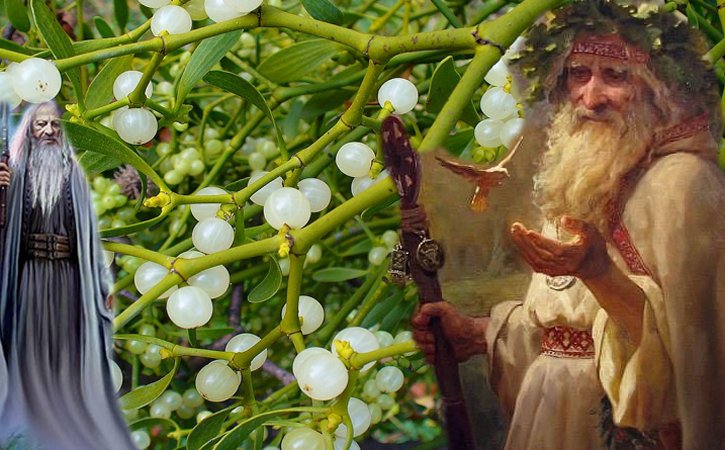Ancient Secrets Of Mistletoe – Sacred Celtic Plant With Magical Powers
Ellen Lloyd - AncientPages.com - Today, we associate mistletoe with Christmas. We decorate with mistletoe and don't think much about how this wonderful plant entered our homes.
To many of us, mistletoe is simply one of many Christmas traditions, but the use of the remarkable plant started a very long time ago.
Mistletoe Offered Protection Against Evil Spirits
Mistletoe is an evergreen plant with white berries that can grow in trees in North America and Europe.
The origins of mistletoe as decoration may lie in the ancient belief that it protected against thunder and lightning and warded off evil spirits.
During the Middle Ages, mistletoe branches were hung from ceilings to ward off evil spirits.
In Europe, they were placed over houses and stable doors to prevent the entrance of witches.
People believed mistletoe possessed mystical powers that could bring good luck to a family during December.
Why Mistletoe Was Sacred To Ancient People
In ancient times, mistletoe was considered a miracle plant and sacred to the Celts, the Norse, and the North American Native Americans. Mistletoe stunts the growth of its host trees and can even kill them if it gets too big.
It may sound strange that a parasite, a plant that sucks the life out of another organism, could inspire such awe, but the mistletoe is unique and much different from most of nature's other parasites.
This beautiful, flowing plant flourishes at a time when all other living creatures fight for life. It seems to grow out of nothing and yet appears to be everywhere. Its growth cannot be controlled, nor, it seems, can the plant be eradicated.
The mistletoe was sacred to Celts. Credit: Adobe Stock - Archivist
Pliny the Elder, the Roman philosopher and naturalist, wrote that the Celts used the plant as an antidote to poison and increase their cattle's fertility. In the Celtic language, mistletoe means "All Heal."
In Norse myths and legends, mistletoe is described as the only thing that could kill the god Balder, the son of the God Odinand brother of the God Thor.
The plant had healing properties, and ancient people considered it sacred. It has been used as an herbal remedy in Europe and by Native Americans for hundreds of years.
It is still an ingredient in some homeopathic medicines, and scholars test the plant's medical use in modern times. It has been used to treat epilepsy, apoplexy, palsy, tuberculosis, stroke, and cancer.
 According to Norse mythology, God Balder was killed by a mistletoe arrow, and his mother, Frigga wept white berries, which brought him back to life. Baldr's Death by Christoffer Wilhelm Eckersberg (1783–1853). Credit: Public Domain
According to Norse mythology, God Balder was killed by a mistletoe arrow, and his mother, Frigga wept white berries, which brought him back to life. Baldr's Death by Christoffer Wilhelm Eckersberg (1783–1853). Credit: Public Domain
In Norse mythology, the mistletoe was a symbol of love and friendship. This explains the origin of the custom of kissing under the mistletoe.
Mistletoe was also a Druidic symbol of joy and peace.
The hanging of mistletoe and the custom kissing beneath it is a popular tradition in Christmas celebrations.
When you bring the plant to your house, don't forget that mistletoe is one of the most magical, mysterious, and sacred plants of all time.
Updated on December 10, 2023
Written by Ellen Lloyd – AncientPages.com
Copyright © AncientPages.com All rights reserved. This material may not be published, broadcast, rewritten or redistributed in whole or part without the express written permission of AncientPages.com
Expand for referencesMore From Ancient Pages
-
 Ancient Health Center Discovered In Philadelphia, Central Anatolia, Turkey
Archaeology | Apr 22, 2016
Ancient Health Center Discovered In Philadelphia, Central Anatolia, Turkey
Archaeology | Apr 22, 2016 -
 Ancient Chinese Version Of Quipu -Tradition Of Tying Knots Dates Back To Antiquity
Civilizations | Mar 15, 2017
Ancient Chinese Version Of Quipu -Tradition Of Tying Knots Dates Back To Antiquity
Civilizations | Mar 15, 2017 -
 Pi-Ramesse: Pharaoh Ramesses II’s Great Capital Surprisingly Identified In Two Locations
Featured Stories | Jun 9, 2022
Pi-Ramesse: Pharaoh Ramesses II’s Great Capital Surprisingly Identified In Two Locations
Featured Stories | Jun 9, 2022 -
 Ggantija Double Temple On Malta Is Older Than Stonehenge And Great Pyramid Of Giza
Civilizations | Jan 16, 2023
Ggantija Double Temple On Malta Is Older Than Stonehenge And Great Pyramid Of Giza
Civilizations | Jan 16, 2023 -
 1,500-Year-Old Ancient Lamps Unearthed In Zerzevan Castle In Southeast Turkey
Archaeology | Nov 25, 2019
1,500-Year-Old Ancient Lamps Unearthed In Zerzevan Castle In Southeast Turkey
Archaeology | Nov 25, 2019 -
 Early Humans In Europe Were Making Fires At Least 250,000 Years Ago – New Study
Archaeology | May 18, 2023
Early Humans In Europe Were Making Fires At Least 250,000 Years Ago – New Study
Archaeology | May 18, 2023 -
 Ice Core Records From Greenland Tell Stories Of Rise And Fall Of Ancient European Civilizations
Archaeology | May 24, 2018
Ice Core Records From Greenland Tell Stories Of Rise And Fall Of Ancient European Civilizations
Archaeology | May 24, 2018 -
 Why Has The Leaning Tower Of Pisa Survived Strong Earthquakes Since The Middle Ages?
Archaeology | May 10, 2018
Why Has The Leaning Tower Of Pisa Survived Strong Earthquakes Since The Middle Ages?
Archaeology | May 10, 2018 -
 Megalithic Giant Tripolye ‘Mega-Structures’ In Large Settlements That Collapsed Around 3650 BC
Archaeology | Oct 1, 2019
Megalithic Giant Tripolye ‘Mega-Structures’ In Large Settlements That Collapsed Around 3650 BC
Archaeology | Oct 1, 2019 -
 On This Day In History: Amelia Earhart, Most Famous Female Pilot – Disappeared Over The Pacific Ocean – On July 2, 1937
News | Jul 2, 2016
On This Day In History: Amelia Earhart, Most Famous Female Pilot – Disappeared Over The Pacific Ocean – On July 2, 1937
News | Jul 2, 2016 -
 Daily Life Of A Lady In Waiting – A Dangerous Profession Sometimes
Ancient History Facts | Aug 24, 2023
Daily Life Of A Lady In Waiting – A Dangerous Profession Sometimes
Ancient History Facts | Aug 24, 2023 -
 Malagana Remarkable Sophisticated Goldwork: Legacy Of Colombian Pre-Hispanic Culture
Artifacts | Nov 14, 2018
Malagana Remarkable Sophisticated Goldwork: Legacy Of Colombian Pre-Hispanic Culture
Artifacts | Nov 14, 2018 -
 DNA Sheds New Light On The Mysterious Dead Sea Scrolls
Archaeology | Jun 2, 2020
DNA Sheds New Light On The Mysterious Dead Sea Scrolls
Archaeology | Jun 2, 2020 -
 God Dagda – A Powerful Leader Of The Tuatha De Danann In Celtic Mythology
Celtic Mythology | May 30, 2020
God Dagda – A Powerful Leader Of The Tuatha De Danann In Celtic Mythology
Celtic Mythology | May 30, 2020 -
 Unsolved Mysteries Of Cahokia – What Really Happened With The Large Metropolis?
Civilizations | Jan 15, 2015
Unsolved Mysteries Of Cahokia – What Really Happened With The Large Metropolis?
Civilizations | Jan 15, 2015 -
 ‘Ali Baba Cave’ Treasures: Burial Boxes Inscribed With Jesus’ Name May Help Reconstruct Jesus’ Life And Death
Archaeology | Mar 21, 2017
‘Ali Baba Cave’ Treasures: Burial Boxes Inscribed With Jesus’ Name May Help Reconstruct Jesus’ Life And Death
Archaeology | Mar 21, 2017 -
 Nine Great Wall Beacon Towers Discovered In China’s Inner Mongolia
Archaeology | Apr 21, 2020
Nine Great Wall Beacon Towers Discovered In China’s Inner Mongolia
Archaeology | Apr 21, 2020 -
 Sunken Land Of Lyonesse: Legendary Kingdom That Influenced Stories Of Writers And Fishermen
Featured Stories | Mar 16, 2017
Sunken Land Of Lyonesse: Legendary Kingdom That Influenced Stories Of Writers And Fishermen
Featured Stories | Mar 16, 2017 -
 Stunning Ancient Khanqah With Large Underground Crypt, Ritual Halls And Burials Discovered In Turkestan
Archaeology | Aug 14, 2020
Stunning Ancient Khanqah With Large Underground Crypt, Ritual Halls And Burials Discovered In Turkestan
Archaeology | Aug 14, 2020 -
 Natural Wonders: ‘Fingal’s Cave’ – An Enigmatic Place Shrouded In Mystery And Legend
Featured Stories | Mar 18, 2023
Natural Wonders: ‘Fingal’s Cave’ – An Enigmatic Place Shrouded In Mystery And Legend
Featured Stories | Mar 18, 2023


